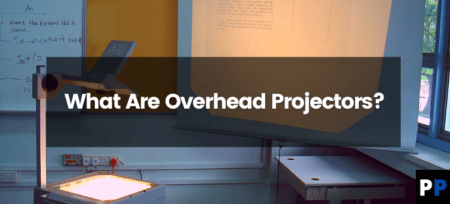The Projector has become an integral component of schools, offices, and universities. You can’t imagine an event without the help of a projector. Nearly all rooms for presentations have projectors. In this article, we will talk about what a Projector is, how it operates, the various kinds (CRT LCD, DLP, and CRT), and its applications, as well as their advantages and disadvantages.
What is a Projector?
A projector is an optical gadget that projects an image or figure onto the surface. This surface is typically white and can be projected onto a white screen or the wall. They can be used instead of a TV or monitor for large crowds.
In simple terms, the term “projector” refers to the fundamental principle of image projection. In other words, the Projector takes in a video or image input and processes it with the help of its internal optical projection system that consists of a lens and optical source and projects an enhanced image onto the Projection screen.
For instance, a projector can show an event on a large screen so that all in the space (maybe an office or conference room) can view the display. Both still images like slides and moving images like videos can be produced by projectors. Most often, they are of the size of a toaster and weigh only a couple of kilograms.
Types of a Projector
The three categories of projectors are based on display quality. They consist of:
Cathode Ray Tube (CRT)
A CRT projector is just another name for a video projector. It is a small cathode-ray tube with high brightness for image generation. A Lens is placed close to the CRT face, which helps focus the image and then enlarges the image to fit on a giant projection screen.
A CRT projector concentrates on an image or video using its lenses to project the photo or video onto the screen. Three colored CRT tubes (red-green, blue, and red) are used to capture the images.
CRT projectors aren’t portable since they are large in dimensions and weight. The power consumption of CRT projectors is excessive due to the three light guns. Initially, installing CRT projectors could be complex and challenging; however, people who have used them say that CRT projector has a stunning and impressive image quality. Many say that CRT projectors remain superior to newer technologies and compatible with the latest advancements.
Liquid Crystal Display (LCD)
It’s easy to see why Liquid Crystal Display is so essential just by its name. LCD refers to two types of matter, solid and liquid. Displays with liquid crystals To design an item or image, liquid crystal screens are used.
This display panel is typically used in computers, TVs, laptops, mobile video games, and mobile phones.
Digital Light Processing (DLP)
Texas Instruments created the video technology known as Digital Light Processing. It can be used in the back and front projection systems very well. Mainly DLP is used for back projections in TVs. It can also be a front projector in group projects and classrooms.
A DLP is available in two distinct designs, i.e., one chip and three-chip. Small mirrors known as digital micromirror devices represent light and shadows onto the display during digital light processing. Micro mirrors are positioned within a semiconductor chip and are tiny. A majority of DLP chips are produced by the company Texas Instruments.
How does a Projector work?
The term “projector” refers to an optical instrument that projects images (or pictures that move) onto the surface, typically projected on a screen. Most projectors create images by projecting an intense light through tiny lenses. But, specific newer models of projectors allow you to project images directly through lasers.
A device that concurrently projects an image on the retina rather than the projection screens of an external screen is known as an electronic retinal display or retinal projection.
Presently, Pico Projectors are also popular since they are incredibly compact (handheld) and compact in terms of size and provide top-quality images.
Applications of a Projector
In Classrooms
Projectors are utilized in schooling in the classroom to describe a subject. With the help of a projector, videos or photos become more fun, and kids can learn in a fun and enjoyable way. Furthermore, we can zoom in or out to make it more transparent and locate minor elements.
In Companies
Projectors are commonly used in large enterprises and MNCs to facilitate conferences, meetings, and presentations.
At Home
You can even use projectors as home theaters to view the movie or serial on a large display with excellent sound quality. It makes it seem like you’re staring at real life.
Advantages of Projector
Large Picture Size
Front projectors produce the most significant possible image size. They can be used to create huge displays resembling a movie theatre’s cinema for business in your home. Most projectors can produce stunning images in lengths of 90”-120 inches in diagonal, much larger than the ones you can obtain with flat-screen or rear-projection televisions.
Best Alternative for Large Screen Television
Projectors are a less expensive alternative to plasmas that are 60 inches in size television. The projected image is generally highly bright and can be used with some lighting in the room.
Low Cost
Front projectors may be the cheapest option for large display screens at home. Specific projectors designed to be used for theater that is dedicated to domestic use and has dropped under $1,000.
With the affordable price of most entry-level projectors, that is the most expensive option to get the most giant screen in your home. While you will need to connect an additional speaker, the quality of the experience is superior to the cost.
Space Saving
The Projector can be placed on a bookcase, back shelf, or ceiling. It takes up very little room. When it is off, it is barely noticeable.
Installing process is so easy.
They’re lightweight, and anyone can take them out of the box, hook them up, and then get an image displayed on the wall without difficulty.
Disadvantages
• A dark space is often needed to install the Projector.
• It is required to be maintained regularly.
• Installation Costs could be higher in certain situations since it depends on how you install it.
• A majority of projectors require a separate audio system.














